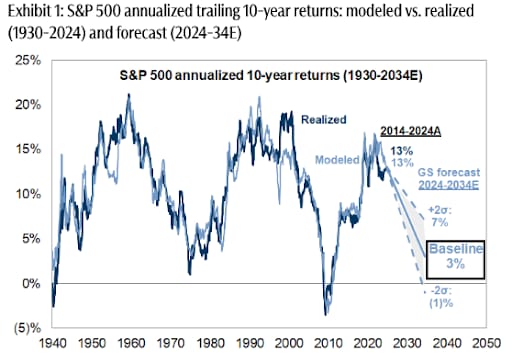- Global Markets Investor
- Posts
- 🚨Global Debt bubble is massive
🚨Global Debt bubble is massive
The US has $38.3 trillion in government debt, accounting for ~33% of total global government debt.
🔥🔥 GLOBAL MARKETS INVESTOR PORTFOLIO — UP 60% SINCE JANUARY 2024 DURING THE MARCH-APRIL 2025 MARKET TURMOIL, MAJOR US INDEXES FELL NEARLY 20%, WHILE THE GMI PORTFOLIO GAINED OVER 5%, FIND OUT HOW BELOW:
The US now has a massive $38.3 trillion in government debt, accounting for ~33% of global debt.
China and Japan follow with $18.7 trillion and $9.8 trillion, meaning the top 3 countries now hold 60% of the world’s total.

Wall Street Isn’t Warning You, But This Chart Might
Vanguard just projected public markets may return only 5% annually over the next decade. In a 2024 report, Goldman Sachs forecasted the S&P 500 may return just 3% annually for the same time frame—stats that put current valuations in the 7th percentile of history.
Translation? The gains we’ve seen over the past few years might not continue for quite a while.
Meanwhile, another asset class—almost entirely uncorrelated to the S&P 500 historically—has overall outpaced it for decades (1995-2024), according to Masterworks data.
Masterworks lets everyday investors invest in shares of multimillion-dollar artworks by legends like Banksy, Basquiat, and Picasso.
And they’re not just buying. They’re exiting—with net annualized returns like 17.6%, 17.8%, and 21.5% among their 23 sales.*
Wall Street won’t talk about this. But the wealthy already are. Shares in new offerings can sell quickly but…
*Past performance is not indicative of future returns. Important Reg A disclosures: masterworks.com/cd.
The UK, France, and Italy follow with $4.1 trillion, $3.9 trillion, and $3.5 trillion, respectively.
Why is the ever-growing debt a concerning issue?
1) When debt gets too big, the government spends more money paying interest instead of investing in things that grow the economy simply crowding out productive investment and limiting fiscal flexibility during downturns.
2) When government debt rises, central banks often buy government bonds (QE - Quantitative Tightening) or keep rates low to manage it. This increases the money supply, which can lead to higher inflation (higher prices). As prices rise, the value of money falls, reducing what each Dollar can buy. Often, wages fail to keep up with this rise in prices.
As a reminder, during 2020–2021, the government borrowed trillions to fund stimulus checks and relief programs. This new debt increased the money supply and helped drive the biggest inflation surge in 40 years.
3) Rising debt can cause higher interest rates (government bond yields) and more market volatility, reducing investor confidence in sovereign stability.
If you find it informative and helpful, consider a paid subscription or become a Founding Member, and follow me on Twitter or Nostr:




